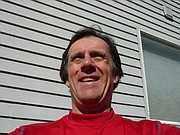The fantastic forehead
By JERRY HITCHCOCK
Staff Writer
Do you give much thought to sweating and cooling off your body during exercise? Maybe you should.
Studies show that covering your forehead can significantly hamper your body’s ability to cool itself off. Findings include the optimum heat-dissipating skin on the human body is found on the forehead, since blood is directed to that region specifically for thermoregulatory cooling during a workout. By covering this region, you curb the dissipation process and increase the heat buildup in the region, which leads to increased sweat production.
On a very cold day, chances are you won’t be working out hard enough for a significant heat buildup to occur, regardless of how many layers you are wearing to stave off the chill. But once temperatures warm up, like we currently have here in North Idaho, a forehead cover will begin to affect the regulatory function.
Most of the studies that I have seen on the subject conclude a sweat rate in the forehead region between 2 and 2 1/2 times the average of any other skin region, making it imperative, especially on hot days, to provide this area access to open air. Optimal performance and the ability to keep the whole body sweat rate in check (important to stave off dehydration and improve recovery) depends on this area like no other.
During strenuous exercise, blood flow to the forehead region can increase up to 12 times the normal amount, with the sole purpose of aiding in cooling the body.
It doesn’t take a rocket scientist to determine a blood flow rise to that degree won’t work out well when its specific role is blocked by a fabric barrier. All that internal heat needs to go somewhere, and subsequently it tends to release itself pretty much everywhere else through your body’s skin.
Sweat rates in people differ, and likewise the environment and type of sport will play a role in how we lose that liquid. A marathon runner working out in August in a region near the equator is suffering through a high sweat rate compared to someone running a few miles at an altitude of a few thousand feet.
There have been times when I ventured out on a run with a fleece cap on my head, thinking I would be able to keep my head warm during a workout without ever considering I may actually be hampering my body’s ability to self-regulate itself.
Knowing what I know now, I’ve found that a thin cap, pulled up to expose my forehead during exercise, works wonders in keeping me from sweating too much in other areas.
Combined with today’s fabric technology relating to workout clothes, I am much more comfortable than the old days of sweat-suits for every exercise occasion.
Sweatbands have long been a staple of various forms of exercise. More often than not, I use one under my cycling helmet to keep sweat from running into my eyes during competition in late fall when the temps have dipped below 40 degrees. I can usually tell during a warm-up prior to competition whether I am wearing too many layers, or to much thickness. If you compete often enough, this becomes second nature, and I find myself erring on the side of wearing too little, knowing the heat I’ll produce during competition will offset the cold more often than not.
After competition, keeping the forehead exposed will aid in cooling the body to normal temps at a good pace. I’ve found this out by returning on a run, skull cap on, and tending to my dog Journey for a few minutes in a warm house. Soon, my body was feeling very moist, enough that I’d have to hit the shower sooner rather than later. Now I come back with a exposed forehead, get some water for me and the dog, and in a few minutes I’m cooled down, with a body that is significantly drier.
See how well these tips work for you. I’m guessing you’ll be pleasantly surprised.
No sweat.
- • •
Jerry Hitchcock can be reached at 664-8176, Ext. 2017, via email at jhitchcock@cdapress.com, or follow him on Twitter at HitchTheWriter.



